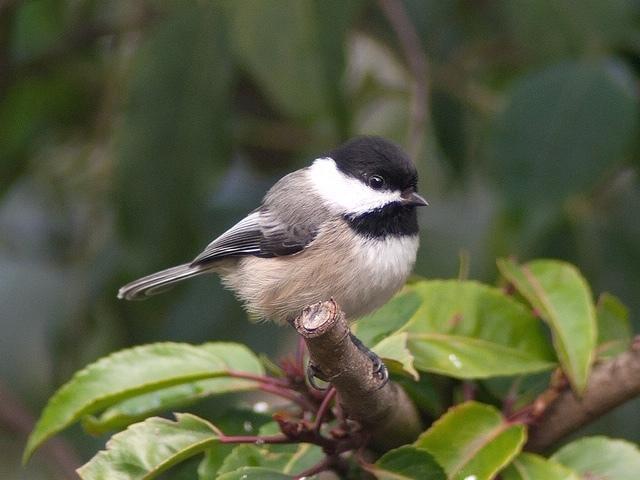Did You Know This About Birds?
Bird Trivia by Dan Gleason
#1 — Observed rate of flicker in birds
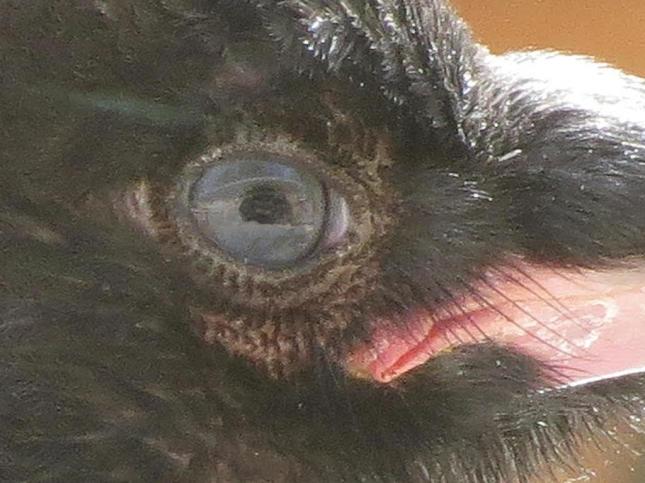
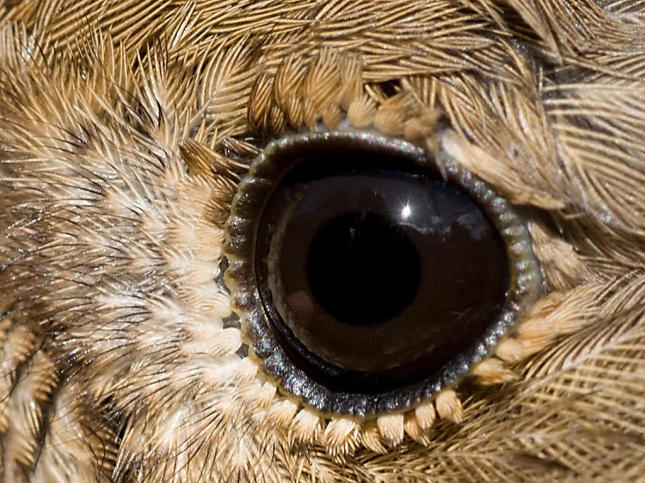
Birds have the ability to see higher flicker frequency rates or cycles per second. Imagine turning a light on an off. The faster you turn it on and off the higher the flicker frequency rate. A fluorescent lamp flickers at a rate of about 60 cycles per second (cps). The human eye is only capable of seeing a rate of 50-55cps, thus the fluorescent light looks continuous because it is flickering faster than we can detect (unless the light slows as it ages and we sometimes become aware of it). Some birds can see flicker rates of over 100cps. The faster we move, the more nearby objects, such as branches, become blurred. The could be a problem for fast-moving birds were it not for the faster flicker frequency rate. A Sharp-shinned Hawk, in quick pursuit of prey through dense woodlands can clearly see and avoid the branches in its path. Just one of the many ways birds’ vision is superior to that of humans.
#2 — Number of feathers on a bird
Over the years, naturalists and researchers have counted the total number of feathers on various species of birds, and the counts range from a low of 940 feathers on a Ruby-throated Hummingbird to a high of 25,216 on a Tundra Swan. Most songbirds have 1,500–4,000 feathers. The greatest concentration of feathers on most birds is around the head and neck, and, in most songbirds this amounts to 30–40% of the total number of its feathers.
#3 — The size of birds
The smallest bird in the world is the Bee Hummingbird, Mellisuga helenae, found only in Cuba. It weighs just 1.6 grams, about 3/4 the weight of a dime. The Anna’s Hummingbird that frequents our skies weighs about 2.75x more than the tiny Bee Hummingbird!
The largest living bird (by weight) capable of flight is the American White Pelican, Pelecanus erythrorhynchos, which has been recorded weighing up to 30 pounds. The Trumpeter Swan, Cygnus buccinator, is a close second with adult males weighing over 26 pounds.
The largest living flying bird (by wingspan) is the Wandering Albatross, Diomedea exulans, with a wingspan of about 12 feet and a weight that may reach 26 pounds, although 23-24 pounds is more typical.
You might already know that the largest living bird is the Common Ostrich, Struthio camelus, of Africa. Males can stand nearly 9 feet tall and weigh up to 320 pounds.
The largest bird that ever lived is the extinct Elephant Bird, Aepyornis maximus, of Madagascar. It stood over 10 feet high and weighed up to 1,600 pounds. Its egg was over 13 inches long and held about 2 gallons in volume. It became extinct about 1,000 years ago, probably because of human activity.
#4 The Bobolink — A long-distant Migrant
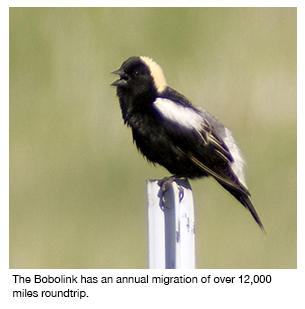 The Bobolink, a member of the Blackbird Family, is common in the grasslands of southern Canada and the northern United States. In Oregon, it is found at Malheur National Wildlife Refuge and a few other locations in eastern Oregon. It is a remarkable long-distant migrant, one of the longest migrations of any songbird. Each year it flies from its breeding grounds in North America to Bolivia and Argentina south of the equator—a distance of about 12,500 miles round-trip. Some birds have been known to live up to 10 years making their lifelong mileage over 125,000 miles per individual—a distance more than 5 times around the world at the equator! To navigate, they use the stars and cues from the Earth’s magnetic field.
The Bobolink, a member of the Blackbird Family, is common in the grasslands of southern Canada and the northern United States. In Oregon, it is found at Malheur National Wildlife Refuge and a few other locations in eastern Oregon. It is a remarkable long-distant migrant, one of the longest migrations of any songbird. Each year it flies from its breeding grounds in North America to Bolivia and Argentina south of the equator—a distance of about 12,500 miles round-trip. Some birds have been known to live up to 10 years making their lifelong mileage over 125,000 miles per individual—a distance more than 5 times around the world at the equator! To navigate, they use the stars and cues from the Earth’s magnetic field.
#5 The Fastest Bird — Peregrine Falcon
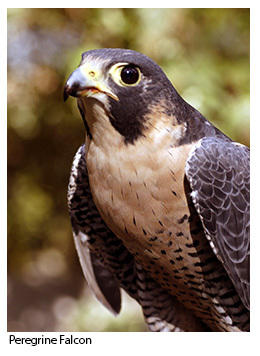 The fastest bird in the world is the Peregrine Falcon. It has been clocked at a speed of 240mph in a power dive. The Golden Eagle is a close second with speeds of over 200mph in a dive. The fastest bird in direct powered flight is the White-throated Needletail, swift of SE Asia and Australia. It has been clocked at a speed of 105mph.
The fastest bird in the world is the Peregrine Falcon. It has been clocked at a speed of 240mph in a power dive. The Golden Eagle is a close second with speeds of over 200mph in a dive. The fastest bird in direct powered flight is the White-throated Needletail, swift of SE Asia and Australia. It has been clocked at a speed of 105mph.
#6 Ducks — How They Find Food in Muddy Water
An unguis is a nail or claw. In ducks, it refers to the nail-like structure on the tip of the bill. This structure is densely packed with sensory cells for touch. These sensory cells are able to discriminate a far lighter touch than other birds or mammals can; a much lighter touch than humans can feel with our fingertips. This helps ducks find food items in muddy water by touch rather than relying on visual cues.
#7 — Pterylae
The feathers in birds grow in defined tracts on the skin over the body. These are called pterylae. There are 8-10 major tracts that can be further subdivided into smaller tracts. The bare regions between these tracts are called apteria. All birds have these tracts except penguins where the feathers are uniformly distributed over the body. There is actually evidence of feather tracts embryonically in penguins but they disappear before the embryo hatches. Even in close-up photos of birds, such as this photo of a Northern Flicker, feather tracts cannot be seen.
An interesting, but unrelated fact, woodpeckers do not have true down feathers.
#8 — Heart Rate in Birds
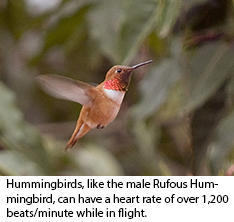 The heart in birds is larger than in comparable sized mammals. The larger heart of a bird pumps more blood per heartbeat than does that of a mammal, and birds at rest typically have a slower heartbeat than a similar-sized mammal. Activities such as flight quickly elevate the heart rate, and small birds have a more dramatic increase in heart rate with exercise than do large birds. A large gull may go from 150-200 beats per minute while at rest to over 600 beats/minute during flapping flight. Hummingbirds may go from a resting heart rate of 500 beats per minute to over 1200 heartbeats per minute while flying. At night a hummingbird goes into torpor and the heart may drop to 40 beats/minute.
The heart in birds is larger than in comparable sized mammals. The larger heart of a bird pumps more blood per heartbeat than does that of a mammal, and birds at rest typically have a slower heartbeat than a similar-sized mammal. Activities such as flight quickly elevate the heart rate, and small birds have a more dramatic increase in heart rate with exercise than do large birds. A large gull may go from 150-200 beats per minute while at rest to over 600 beats/minute during flapping flight. Hummingbirds may go from a resting heart rate of 500 beats per minute to over 1200 heartbeats per minute while flying. At night a hummingbird goes into torpor and the heart may drop to 40 beats/minute.
#9 — Eagle Eyed
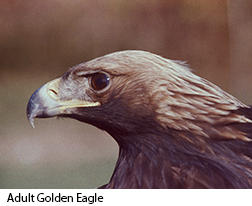 Do eagles really see 7X better than we do? Well, that depends upon what you mean by better. Eagles, and other birds of prey, do see an object that is 7X larger than we do. The difference is in resolution. In the central part of the eye (macula is the term used in humans and fovea is the term used for birds and most other animals) will be found the highest number of cones. Cones are responsible for color and sharpness. We have approximately 200,000 cones per square millimeter. Eagles have over 1,000,000. Think of it as similar to pixel on a computer screen—the more pixels, the higher the resolution and the sharper, more detailed the image. If you look at a barcode of a grocery store item from across the room, you probably can’t see the lines clearly. If you simply magnify it the image will be bigger but just as fuzzy. The eagle can still “resolve”, or clearly see those lines across the room with magnifying them. It’s not just eagles and raptors that have this ability, Swifts and swallows need to see flying insects while flying fast themselves and flycatchers need these visual skill to see their prey.
Do eagles really see 7X better than we do? Well, that depends upon what you mean by better. Eagles, and other birds of prey, do see an object that is 7X larger than we do. The difference is in resolution. In the central part of the eye (macula is the term used in humans and fovea is the term used for birds and most other animals) will be found the highest number of cones. Cones are responsible for color and sharpness. We have approximately 200,000 cones per square millimeter. Eagles have over 1,000,000. Think of it as similar to pixel on a computer screen—the more pixels, the higher the resolution and the sharper, more detailed the image. If you look at a barcode of a grocery store item from across the room, you probably can’t see the lines clearly. If you simply magnify it the image will be bigger but just as fuzzy. The eagle can still “resolve”, or clearly see those lines across the room with magnifying them. It’s not just eagles and raptors that have this ability, Swifts and swallows need to see flying insects while flying fast themselves and flycatchers need these visual skill to see their prey.
#10 — Bird Ovaries
In most birds the females have only one functional ovary and oviduct, usually the left one. The right ovary and oviduct typically degenerate early in embryonic development. Eggs nearly ready to be released from the ovary, contain the yolk material. When an egg is released from the ovary, it typically takes only one day for the egg to travel down the oviduct, acquire albumen and additional materials added. Once it reaches the uterus at the end of the oviduct (a process that takes 4-5 hours) a shell put on to surround the egg and make it ready to be laid. This takes about 20 more hours. The egg will then turn and be pushed from the body large end first.
If both ovaries and oviducts were functional and contained mature eggs, the females of many species would have great difficulty, or even be unable to fly until unburdened of one or even both eggs. This situation actually occurs in some steamer ducks that are nearly unable to fly even without the weight of an egg and cannot fly for a day or two while carrying a mature, unlaid egg.
#11 — Some Birds Eat Ash
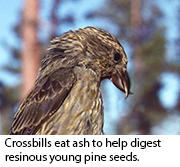 Some birds have been seen at ash pits. Look closely if you see this behavior. Maybe they are searching through the ashes for insects, but maybe, they are actually eating some of the ash.
Some birds have been seen at ash pits. Look closely if you see this behavior. Maybe they are searching through the ashes for insects, but maybe, they are actually eating some of the ash.
Strange as it seems, hummingbirds, especially in the southwest, will sometimes eat ashes. This seems like an odd diet for a hummingbird. It is always the females in most species that eat ash, rarely do males do so, and other species of birds eat ashes as well
Ash is high in calcium and eating ash is a quick way to help return lost calcium. Why females? To produce a clutch of eggs, females often become deficient in calcium used to produce the shell.They often even deplete some of the calcium in their own bones. Eating bits of eggshell fragments or the fecal sacs of the young can provide a quick way to obtain some calcium, but charcoal is also a possible source. Campfires that are heavily doused with water may leach out the calcium into the surrounding soil but fires allowed to extinguish naturally are usually higher in calcium. This was the findings from a study done on Boreal Chickadees in Newfoundland in the 1980s. In that study, the Boreal Chickadees ignored ash pits with low calcium content.
Crossbills have a different reason for eating ash and in crossbills, males also eat ash. These birds may feed on ashes more than any other North American bird. Crossbills feed on conifer seeds by prying open young cones. The immature seeds that they feed on have not yet dried and are still somewhat resinous. This sticky resin can cause digestive problems. To help moderate this problem and facilitate digestion, crossbills eat from clay deposits and charcoal where available. This helps absorb some of the resin, allowing the birds to digest the seeds more easily.
An interesting related behavior is observed in some macaws in South America. Their massive bill allows them to feed on the seeds of some trees that other birds cannot eat. Some mammals may have the teeth to break apart these seeds but ignore them because they contain compounds that are mildly toxic. (Or in the case of the liana tree, very toxic. Those seeds contain strychnine.) The macaws feed on these seeds with immunity, but only for one reason—After eating these seeds, they fly to areas with large exposed clay deposits. Again, their large beak assists them in obtaining large amounts of clay that they readily consume. The clay absorbs the toxins awhich are then passed out of the body harmlessly.
#12 — Deep Forest Voices
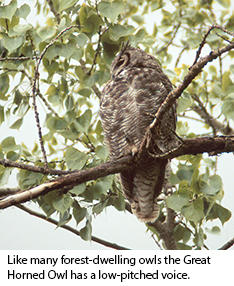 Some birds, like some owls, have deeper-pitched voices than other similar birds. Is this just happenstance or is there some reason for this? In owls, those that live in dense forests have deeper voices than owls that live in open country.
Some birds, like some owls, have deeper-pitched voices than other similar birds. Is this just happenstance or is there some reason for this? In owls, those that live in dense forests have deeper voices than owls that live in open country.
Sound carries relatively well in open country but is quickly absorbed by vegetation of forests and bushes. Lower frequencies travel farther, even in dense vegetation, than do higher frequencies. So, Great Horned Owls, Spotted Owls, and other. forest-dwellers all tend to have low voices. If there is a need to hold a large territory, the voice may be even lower to reach a longer distance. Flammulated Owls are small, yet they have very low voices. Their territory is quite large. larger than similar-sized Screech-Owls, and their voice is lower, traveling a longer distance into the woods. The male is the one who most defends the territory and his voice is lower than that of the female, even though she is larger is size.
Other birds, like Sooty Grouse, also have very low voices. These grouse are generally solitary birds and when the time comes to attract a mate, they must attract the attention of females who may be at a considerable distance from them. The first method of attraction is by voice and the very low voice of Sooty or Spruce Grouse carries a long distance through the forest.
Of course, not all forest-dwellers have low-pitched voices. Pacific Wrens have a long high-pitched song. The voice is quickly absorbed by the vegetation, but the wren has no need for its voice to travel far. It holds a small territory and its high voice is very effective for its needs. His neighbors can hear him well and there is no need to be heard by distant wrens.
Low frequency sounds travel far but can be difficult to locate. High frequency sounds are quickly absorbed by leaves and other vegetation but are easily pin-pointed. Golden-crowned Kinglets make high-pitched vocalizations as they travel through the conifers, high above the ground. Such high sounds don’t travel far to attract the attention of others, but they help with flock integrity, allowing each bird of the group to easily locate their neighbors and stay together.
#13 — Very High-Altitude Flying of Birds
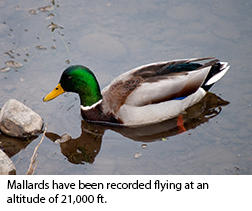 The Bar-headed Goose of Asia, migrates at high altitudes. It can fly over the highest parts of the Himalayas, including over the summit of Mt. Everest. By doing so, it can take advantage of the jet stream and reach flight speeds of over 90 mph allowing completion of a 400-600 mile journey in a single day and avoid a multi-day journey at lower elevations around the mountains. Even Mallards have been recorded flying over 21,000 ft. in altitude and a Golden-crowned Sparrow was struck by a small plane at 10,000 ft. To fly over 20,000 ft. means that the birds encounter an air pressure that is less than ⅓ of the pressure found at sea level and temperatures are nearly -60°F. To survive, special adaptations are needed. Birds that fly at high elevations often have two forms of hemoglobin, the oxygen-carrying molecule of the blood. The second form of hemoglobin is able to capture and release O2 with greater efficiency at high altitudes and this form is equal to or is more concentrated in the blood than the “normal” form in such high-flying birds. Additionally, because oxygen is at lower concentrations at high altitudes, the birds must breathe faster, and the exertion of flying increases the breathing rate even more. This causes the carbon dioxide (CO2) to become more concentrated in the blood which increases the pH of the blood (making it more alkaline). The normal pH of the blood is 7.3-7.4. In this very high-altitude flying, the blood of these birds may reach a pH of 8.0, a condition that would be fatal to humans. No one yet knows how these birds survive such extremes of pH, but all of these marvelous adaptations allows the annual migration of these geese to be possible.
The Bar-headed Goose of Asia, migrates at high altitudes. It can fly over the highest parts of the Himalayas, including over the summit of Mt. Everest. By doing so, it can take advantage of the jet stream and reach flight speeds of over 90 mph allowing completion of a 400-600 mile journey in a single day and avoid a multi-day journey at lower elevations around the mountains. Even Mallards have been recorded flying over 21,000 ft. in altitude and a Golden-crowned Sparrow was struck by a small plane at 10,000 ft. To fly over 20,000 ft. means that the birds encounter an air pressure that is less than ⅓ of the pressure found at sea level and temperatures are nearly -60°F. To survive, special adaptations are needed. Birds that fly at high elevations often have two forms of hemoglobin, the oxygen-carrying molecule of the blood. The second form of hemoglobin is able to capture and release O2 with greater efficiency at high altitudes and this form is equal to or is more concentrated in the blood than the “normal” form in such high-flying birds. Additionally, because oxygen is at lower concentrations at high altitudes, the birds must breathe faster, and the exertion of flying increases the breathing rate even more. This causes the carbon dioxide (CO2) to become more concentrated in the blood which increases the pH of the blood (making it more alkaline). The normal pH of the blood is 7.3-7.4. In this very high-altitude flying, the blood of these birds may reach a pH of 8.0, a condition that would be fatal to humans. No one yet knows how these birds survive such extremes of pH, but all of these marvelous adaptations allows the annual migration of these geese to be possible.
#14 — Staying On A Perch
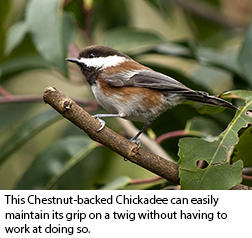 How does a bird perch on a twig without becoming unbalanced? Even more curious, how does a bird sleep on a perch through the night without falling off? It seems like the muscles must get tired gripping tightly through the night. In fact, the muscles don't need to do any work at all. A special arrangement of tendons helps hold the foot securely.
How does a bird perch on a twig without becoming unbalanced? Even more curious, how does a bird sleep on a perch through the night without falling off? It seems like the muscles must get tired gripping tightly through the night. In fact, the muscles don't need to do any work at all. A special arrangement of tendons helps hold the foot securely.
When looking at a birds foot, many people assume that the knee bends backwards as compared to our knee. But that rear pointing joint is actually the ankle and what we think of as the birds’ foot, is just its toes. In a bird, the long bones between the ankle and toes are fused together and elongated into one long bone. The knee works the same as ours, but it is usually hidden from our view by the body’s feathers. The muscles of the leg are above the knee. A tendon runs from these muscles down the length of the lower leg, wraps around behind the ankle, extending to the toes, and branching out underneath the bones of each toe. As the bird sits upon a perch and the ankle bends, this tendon is stretched. In doing so, the bones of the toes are pulled together and curl around the perch, holding the bird tightly in place. Additionally, in songbirds, the tendon is wrapped in a sheath which has tiny ridges along its length. These ridges match corrugations in the tendon. As the weight of the bird pushes down against the perch, the corrugations of the tendon interlock with the ridges of the sheath and this prevents the tendon from sliding in its sheath as the bird sits on the perch. With this adaptation, the muscle does no work and the bird easily sits in place without concern of falling off. As the bird takes flight, it pushes upward, releasing this locking mechanism and relaxing the tendon, making it easy to release from the perch. It should be noted that a bird can voluntarily open its foot anytime it wishes while perched, but this adaptation makes sitting on a perch easy to do without the need to constantly grip it.
#15 — Eating Poison-oak
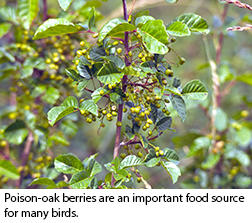 Poison-oak is a plant we should all know how to identify and avoid. It causes an irritating rash on the skin of many people and can make you very ill is taken internally (inhaling poison-oak smoke or using twigs to roast hot dogs). But humans are one of the few species to react negatively to this plant. It is an important native plant and several kinds of birds will use poison-oak.
Poison-oak is a plant we should all know how to identify and avoid. It causes an irritating rash on the skin of many people and can make you very ill is taken internally (inhaling poison-oak smoke or using twigs to roast hot dogs). But humans are one of the few species to react negatively to this plant. It is an important native plant and several kinds of birds will use poison-oak.
Poison-oak thickets provide cover for nesting for some birds and its berries are eaten by many different species of birds. If fact, for some birds, poison-oak berries can be 5-10% or more of the berries they eat. Those birds in the west include: Red-breasted Sapsucker, Downy Woodpecker, Northern Flicker, Ruby-crowned Kinglet, Hermit Thrush, Wrentit and several other species in other parts of the country. Other species with less dependence on these berries, but who still have been seen eating them are: Ring-necked Pheasant, Wild Turkey, California Quail, Lewis’s Woodpecker, Hairy Woodpecker, Warbling Vireo, Black-billed Magpie, American Crow, Black-capped Chickadee, Mountain Chickadee, Chestnut-backed Chickadee, Bushtit, Swainson’s Thrush,Varied Thrush, Cedar Waxwing, European Starling, Yellow-rumped Warbler, Spotted Towhee, Golden-crowned Sparrow, White-crowned Sparrow, Dark-eyed Junco and Purple Finch.
In addition to the berries some mammals will also eat the berries and even the foliage. These include: Black Bear, Muskrat, mice, and Black-tailed Deer.
So, while you may not like making contact with this plant, it is an important native species in our ecosystem and should not be eradicated in natural areas.
#16 — Townsend’s Warblers and Honeydew
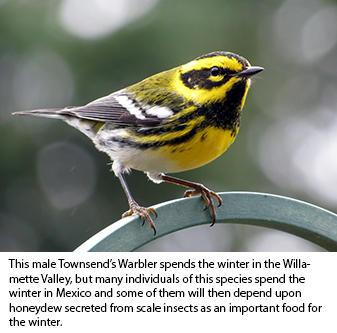 Honeydew is a sugar-rich liquid secreted by some aphids and scale insects. As the insect pierces into the phloem of a plant the pressure causes the sugary liquid to be extruded from the insect’s anus. Some ants tend aphids so that they can feed on the honeydew. But ants aren’t alone in dining on the sugar-rich food source. During the winter months, many Townsend’s Warblers migrate to Mexico. Insects gleaned from the surfaces of plants are the primary food throughout the year for these warblers. But some migrate to an area of Mexico where there is an abundance of scale insects. Here, Townsend’s Warblers have found another food source—honeydew from scale insects. So important is this as a food source that the warblers setup and defend a territory where these insects are abundant, Certainly a unique and interesting food source for one of our most beautiful western birds.
Honeydew is a sugar-rich liquid secreted by some aphids and scale insects. As the insect pierces into the phloem of a plant the pressure causes the sugary liquid to be extruded from the insect’s anus. Some ants tend aphids so that they can feed on the honeydew. But ants aren’t alone in dining on the sugar-rich food source. During the winter months, many Townsend’s Warblers migrate to Mexico. Insects gleaned from the surfaces of plants are the primary food throughout the year for these warblers. But some migrate to an area of Mexico where there is an abundance of scale insects. Here, Townsend’s Warblers have found another food source—honeydew from scale insects. So important is this as a food source that the warblers setup and defend a territory where these insects are abundant, Certainly a unique and interesting food source for one of our most beautiful western birds.
#17 — Brood Patch
The feathers on the breast of a bird provide a very efficient insulation layer. If this layer of feathers were between the adult’s body and eggs in the nest, then transfer of heat from adult to eggs would not be adequate to keep the developing embryo warm. To overcome this problem, most birds develop a brood patch (also known as an incubation patch). This is an area on the breast of the adult bird (male or female) that is devoid of feathers, thus allowing direct contact between eggs and bare skin and a more efficient transfer of heat. The skin of this patch becomes soft to wrap around the eggs and the region becomes engorged with blood to bring more heat to the eggs.
A brood patch can develop as a single region, which is the case in most songbirds, or it may develop in two or three smaller patches with normal feathering in between, as is found in gulls. Waterfowl do not form a true brood patch but pluck down feathers from their breast (which are then often used to line their nest) and spread these feathers away from the eggs prior to sitting on the eggs.
Where incubation duties are equally shared, both sexes form patches. In many songbirds, both male and female form a brood patch but in some species, especially where the female is mostly responsible for incubation, the males have a much less developed patch or none, even though they occasionally sit on the eggs.
While direct contact with the skin is the normal method for incubation, some birds have evolved other mechanisms to warm their eggs. Boobies usually lay two eggs and the eggs are warmed by wrapping their feet around the eggs. Gannets most often use this same technique, but have only one egg. The webbing of the feet is highly vascularized and allows efficient heat transfer.
#18 — Baiting for Fish
 Many kinds of birds catch and eat fish, but the Green Heron actively uses bait to attract fish, making it one off only a few tool-using birds. Green Herons hunt for fish in shallow water usually waiting patiently, as do other herons, for a fish to swim by closely enough to be captured. But, sometimes a Green Heron will seek out some bright object and gently place it on the surface of the water. This attracts the attention of fish which come to investigate. In doing so, the Green Heron has a easy opportunity to capture the fish. If the object has drifted away, the heron may grab it again and once more place it on the water nearby to wait for another fish. A small, yellow leaf or any other bright object can serve as a good natural bait, Once, Barbara and I were visiting nature reserve (Bolsa Chica, south of Los Angeles) where we watched a young Green Heron snatch a goldfish cracker that someone had left near the edge of the water. The heron picked up this small, yellow cracker and gently placed it on the water. Sure enough, it was soon rewarded with the easy capture of a fish that came to investigate.
Many kinds of birds catch and eat fish, but the Green Heron actively uses bait to attract fish, making it one off only a few tool-using birds. Green Herons hunt for fish in shallow water usually waiting patiently, as do other herons, for a fish to swim by closely enough to be captured. But, sometimes a Green Heron will seek out some bright object and gently place it on the surface of the water. This attracts the attention of fish which come to investigate. In doing so, the Green Heron has a easy opportunity to capture the fish. If the object has drifted away, the heron may grab it again and once more place it on the water nearby to wait for another fish. A small, yellow leaf or any other bright object can serve as a good natural bait, Once, Barbara and I were visiting nature reserve (Bolsa Chica, south of Los Angeles) where we watched a young Green Heron snatch a goldfish cracker that someone had left near the edge of the water. The heron picked up this small, yellow cracker and gently placed it on the water. Sure enough, it was soon rewarded with the easy capture of a fish that came to investigate.
#19 — Shorebirds & Biofilm
 Many shorebirds have beaks designed for pecking at the surface or probing below the surface. Invertebrates have long been considered the primary prey. But, it has been found that invertebrates alone cannot account for all of the nutrition in some species. Many of the smaller species, especially the genus Calidris, have small spines at the tip of their tongues. It has been recently demonstrated that these spines assist with the uptake and consumption of something called biofilm. Biofilm is a complex matrix of bacteria and/or other single cells that adhere together and often on a surface. Dental plague is a type of biofilm. A kind of biofilm covers many intertidal mudflats. It consists of bacteria and algae, mostly diatoms, concentrated in a sticky mucilage. The bacteria and diatoms coat the surface of intertidal kelp and other seaweeds. As it is washed off of the plants, the mucilage helps them to adhere to the mud rather than be washed out to sea as the tide retreats. Until recently, it was not known that this is vital as a food for many migrating small sandpipers. So as they forage along the mudflats, they are gathering more than just invertebrates living in the mud.
Many shorebirds have beaks designed for pecking at the surface or probing below the surface. Invertebrates have long been considered the primary prey. But, it has been found that invertebrates alone cannot account for all of the nutrition in some species. Many of the smaller species, especially the genus Calidris, have small spines at the tip of their tongues. It has been recently demonstrated that these spines assist with the uptake and consumption of something called biofilm. Biofilm is a complex matrix of bacteria and/or other single cells that adhere together and often on a surface. Dental plague is a type of biofilm. A kind of biofilm covers many intertidal mudflats. It consists of bacteria and algae, mostly diatoms, concentrated in a sticky mucilage. The bacteria and diatoms coat the surface of intertidal kelp and other seaweeds. As it is washed off of the plants, the mucilage helps them to adhere to the mud rather than be washed out to sea as the tide retreats. Until recently, it was not known that this is vital as a food for many migrating small sandpipers. So as they forage along the mudflats, they are gathering more than just invertebrates living in the mud.
#20 — Rictal Bristles
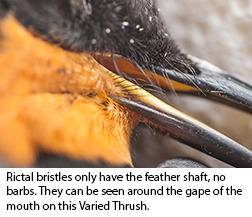 Birds that feed by catching insects on the wing—swallows, flycatchers, and especially nightjars—often have many elongated bristles around the base of the mouth called rictal bristles. The gape at the base of the mouth is called the rictus, hence the name of these bristles located there. The bristles are modified feathers that have only a shaft, no barbs. These were once thought to serve partly as an insect trap but this idea has long been disproved. Work with flycatchers shows that the flycatcher catches the insect with the tip of the beak and these bristles are not involved, They may help protect the eyes from nearly missed insects, from the moving legs of captured, long-legged insects, or from small objects in the air while in flight.
Birds that feed by catching insects on the wing—swallows, flycatchers, and especially nightjars—often have many elongated bristles around the base of the mouth called rictal bristles. The gape at the base of the mouth is called the rictus, hence the name of these bristles located there. The bristles are modified feathers that have only a shaft, no barbs. These were once thought to serve partly as an insect trap but this idea has long been disproved. Work with flycatchers shows that the flycatcher catches the insect with the tip of the beak and these bristles are not involved, They may help protect the eyes from nearly missed insects, from the moving legs of captured, long-legged insects, or from small objects in the air while in flight.
Rictal bristles are found in many species of birds that are non-insectivorous, or at least not entirely so. Most thrushes have rictal bristles at the base of the mouth as do kiwis and many other birds. For many birds, sensory cells have been found at the base of these bristles and movement of the bristle stimulates these sensory cells. Most ornithologists now believe that the bristles are sensory in nature and provide some feedback about the surrounding environment. However, there is very little direct evidence about the role of these bristles in most species and it it possible that there are other functions we are not aware of. There is some evidence that these bristles arose independently over the course of evolution in totally unrelated groups of birds. If so, the functions may vary among the different orders or families of birds having bristles.
#21 — How Vultures Can Stay Cool
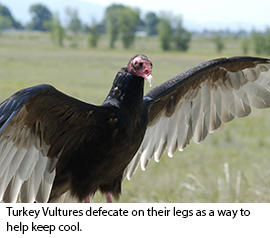 Storks and New World Vultures (but not vultures of Europe, Asia and Africa) all share a common way of keeping cool. They urinate and defecate on their legs. The term for this urohidrosis (often misspelled as urohydrosis). It sounds very unsanitary to us, but it works very well for these birds. Birds don’t have sweat glands so moisture evaporating from the droppings on their legs provides the same evaporative cooling as sweating in humans would. Additionally, these birds eat carrion and are exposed to. disease and parasites and defecating on the legs can help act as a barrier to some parasites and disease. (Seals and Sea Lions sometimes use the same trick, peeing on their hind limbs, when spending time on land.)
Storks and New World Vultures (but not vultures of Europe, Asia and Africa) all share a common way of keeping cool. They urinate and defecate on their legs. The term for this urohidrosis (often misspelled as urohydrosis). It sounds very unsanitary to us, but it works very well for these birds. Birds don’t have sweat glands so moisture evaporating from the droppings on their legs provides the same evaporative cooling as sweating in humans would. Additionally, these birds eat carrion and are exposed to. disease and parasites and defecating on the legs can help act as a barrier to some parasites and disease. (Seals and Sea Lions sometimes use the same trick, peeing on their hind limbs, when spending time on land.)
The black color can also help keep vultures cool. This may seem contradictory as black absorbs heat and you will often see Turkey Vultures holding out their wings early in the morning to absorb sunlight and warm themselves. During this time the feathers are pressed close to the skin so that the sunlight penetrates to help warm the bird. Later, especially while in flight the feathers are lifted slightly above the skin. The sun warms the black feathers and this causes a slight air current to occur between the feathers and skin which causes the warm air to be pulled away from the skin and help cool the skin, keep the bird from overheating. Crows, Ravens and other black-colored birds of warm climates use the same trick to stay cool.
#22 — Eating Feathers
All species of grebes share a common behavioral trait—they all eat feathers. And not just any feathers, they pluck feathers from their own breast and swallow them. The first meal many newly-hatched chicks get is a feather plucked from their parent’s breast. This would seem to provide little nutrition so why do grebes do this odd behavior?
The feathers are not digested and do not pass beyond the stomach. Up to 50% of the stomach may be filled with feathers. It is thought that these feathers provide a barrier and help protect the stomach from being pierced by sharp fish bones. Grebes are fish-eating birds and swallow the fish whole. The proventriculus (fore-stomach) is responsible for enzymatic digestion and is usually well-developed in fish-eating and meat-eating birds. But in grebes, it does not dissolve the bones and the gizzard does not completely crush the bones. So, feathers, swallowed by the birds, provide a protective barrier. The fish bones are trapped by these feathers and eventually some of these feathers that now contain fish bones will be regurgitated as a pellet and disposed of by the grebe. Pied-billed Grebes eat fewer fish than most grebes and the Least Grebe eats the fewest fish of all grebes and has the smallest feather ball in its stomach and the Pied-billed Grebe only a few more. Apparently, fewer swallowed feathers are needed if fewer fish are consumed.
#23 — Chickadee Brains
Black-capped Chickadee change the size of their brain throughout the year. It was once believed that the brains of animals, once fully developed, were fixed and no new growth could occur. We now know that is not true and the Black-capped Chickadee has helped us better understand that. As summer wanes and fall begins, the brain of the Black-capped Chickadee begins to enlarge. In particular, that portion of the brain responsible for memory grows. Throughout the spring and summer, insects are abundant and a primary source of food for chickadees and are especially important as a food for developing young. As fall arrives, insects become less abundant and seeds become more important to chickadees. Many seeds are cached to be used later as food resources become more scarce during the coming winter. That portion of the brain responsible for memory enlarges, allowing the chickadee to recall where all of those seeds are stored. As spring once again approaches and insects become more prominent, this memory is no longer as important and the brain shrinks in size again. This remarkable change may occur in many other birds but this phenomenon has only been well-studied in Black-capped Chickadees thus far.
#24 — Body Temperature
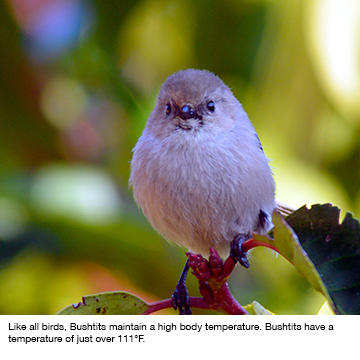 Birds and mammals are the only kind of animals that maintain a constant body temperature. The body temperature of birds is very high, in fact, their core body temperatures would be a very high fever for us. The core body temperature of birds is 102-109°F. Such temperatures are at about the maximum possible for survival. Above this temperature, many proteins start to break down. Such high temperatures create a rapid metabolism and allow muscles to stay warm allowing for the ability of rapid take-off. The brain is especially sensitive to high temperatures and in most birds, the brain is kept cooler than the core body temperature. Evaporative cooling. This lower brain temperature is accomplished by heat exchanged from cooler blood around the nasal passages and warmer blood flowing toward the head. For most birds the core body temperature is warmer than the surrounding ambient air. When air temperatures are greater than a bird’s body temperature, the only way the bird can cool down is through evaporative cooling, usually by panting since birds don’t have sweat glands. Such action means that the bird will lose precious body moisture.
Birds and mammals are the only kind of animals that maintain a constant body temperature. The body temperature of birds is very high, in fact, their core body temperatures would be a very high fever for us. The core body temperature of birds is 102-109°F. Such temperatures are at about the maximum possible for survival. Above this temperature, many proteins start to break down. Such high temperatures create a rapid metabolism and allow muscles to stay warm allowing for the ability of rapid take-off. The brain is especially sensitive to high temperatures and in most birds, the brain is kept cooler than the core body temperature. Evaporative cooling. This lower brain temperature is accomplished by heat exchanged from cooler blood around the nasal passages and warmer blood flowing toward the head. For most birds the core body temperature is warmer than the surrounding ambient air. When air temperatures are greater than a bird’s body temperature, the only way the bird can cool down is through evaporative cooling, usually by panting since birds don’t have sweat glands. Such action means that the bird will lose precious body moisture.
#25 — Birds & Infrasound
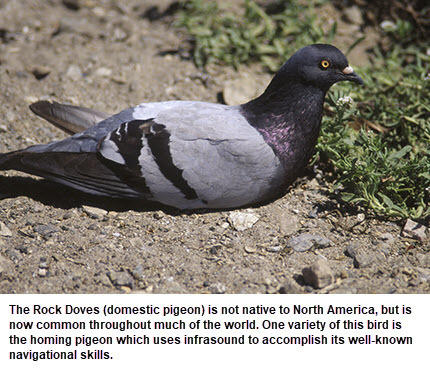 You may know that birds see better than humans. But, they also hear far better than we do!
You may know that birds see better than humans. But, they also hear far better than we do!
The range of human hearing is usually defined as 20 Hz – nearly as low as elephants make at 16-17 Hz, to 20,000 Hz (or cycles per second) about as high as that super high squeal from a light bulb about to burn out.
However, most adults have lost the ability to hear very low tones, and higher frequencies disappear increasingly with age. Normal human speech falls within the range of 90-225 Hz. A tympani is tuned to just below 131 Hz.
Sounds below 20 Hz are referred to as infrasound. Elephants often communicate using sounds of 16-17 Hz, and some new research suggests they can produce sounds as low as 5 Hz. Whales often use sounds as low as 7 Hz. When animals use such low frequencies it allows their sound communication to reach out long distances. Elephants communicate at distances of 1-1.5 miles and whales can hear each other 100 miles away (because sound travels faster and farther in water). Natural, non-living sources also produce infrasound: volcanoes, small earthquakes, ocean surf, large storms and many other things are sources of infrasound. Some of these sounds can be detected hundreds or even thousands of miles from their source.
Would it surprise you to know that some birds are known to hear and use infrasound? The best known example of this use is homing pigeons. These birds apparently become familiar with the infrasound that occurs at their home location, creating, in effect, an infrasound map. Once released at a different location, they use infrasound to navigate and return to their familiar acoustical home via sound. Man-made sounds or large land masses (mountains) can disrupt such sound signals, though, and the birds can become lost. Many other pigeons can also hear infrasound although it is not well-studied how they may use such sound.
Other bird species may make use of infrasound as well. Some birds can detect pressure waves from oncoming storms, allowing them to leave an area before the storm hits, or they may be able to avoid such storms while in migration.
An example is just before a powerful super cell storm struck in the mountains of East Tennessee, a group of Golden-winged warblers abruptly left their breeding grounds when the storm was between 250-500 miles away. They disappeared 2-3 days before the storm arrived, and the storm spawned 84 tornadoes and killed 35 people! They were discovered to have flown about 930 miles away, and they returned after the storm was over. Other birds are known to avoid storms well ahead of them while on their migration route.
As you can see, we are just beginning to learn some of the amazing capabilities our feathered friends have.
#26 — Largest Birds
 The Common Ostrich of Africa is the world’s largest living bird. It can stand over 6ft. tall and weigh over 245 lb. At this size, these birds are, of course, flightless. There have been many other very large flightless birds that have existed in the past and some of these were much larger than the Ostrich. The largest of all birds to have ever lived are the Elephant Birds of Madagascar. Standing over 9 ft. tall and weighing over 1,200 lbs., Aepyornis maximus has long been considered to be the largest bird to have ever lived, but recently, another species of Elephant Bird, Vorombe titan has been discovered to be even larger. It also stood over 9 ft. tall but weighed up to 1,600 lbs. Elephant birds laid eggs that were 13 in. long and had a volume equivalent to 160 modern chicken eggs.
The Common Ostrich of Africa is the world’s largest living bird. It can stand over 6ft. tall and weigh over 245 lb. At this size, these birds are, of course, flightless. There have been many other very large flightless birds that have existed in the past and some of these were much larger than the Ostrich. The largest of all birds to have ever lived are the Elephant Birds of Madagascar. Standing over 9 ft. tall and weighing over 1,200 lbs., Aepyornis maximus has long been considered to be the largest bird to have ever lived, but recently, another species of Elephant Bird, Vorombe titan has been discovered to be even larger. It also stood over 9 ft. tall but weighed up to 1,600 lbs. Elephant birds laid eggs that were 13 in. long and had a volume equivalent to 160 modern chicken eggs.
Elephant Birds co-existed with humans and may have lived as recently as 1,000 years ago. It is thought likely that their extinction was human-caused. It has been suggested that such a large bird would have made a very formidable creature to hunt, but the eggs may have been more easily taken and would have made a rich source of nutrition. Continued pressure from egg hunting would have soon brought the birds to extinction. But, this idea may have to be rethought.
New research has turned up elephant bird bones with distinct cut marks, indicating that these birds were hunted. These bones were found to be 10,000 years old. This means that humans arrived on Madagascar at least 6,000 years earlier than previously thought, and it means that humans and elephant birds co-existed for at least 9,000 years, so extinction at human hands is less likely to be the entire story of elephant bird extinction. Forests becoming deserts, through climate change and human activities, may also play a role in these massive birds meeting their end.
The large, thick-shelled eggs persisted for many years after the birds were gone. Shell fragments can still be found today. Between 1830 and 1840 European travelers to Madagascar reported the native people using bowls that appeared to be large eggshell halves. In the mid-1600s there were undocumented reports of very large birds in the wild forests and even Marco Polo wrote of hearing reports of very large birds that are now thought to be elephant birds. Madagascar currently has many of its native species listed as endangered or severely threatened and sadly, the rampant logging of the forests continues.
#27 — Hardy Little Birds
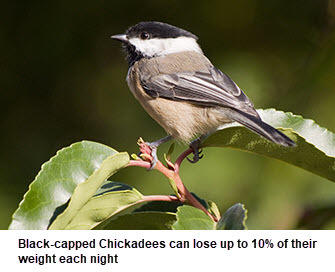 Don’t make the mistake of thinking Black-capped Chickadee are frail just because they are small. These are very hardy little birds, capable of surviving bitter cold better than most birds. In fact, Black-capped Chickadees survive very cold Alaskan winter nights where the dark lasts up to 18 hours and temperatures drop to below -40°F during those dark hours. How do they accomplish this?
Don’t make the mistake of thinking Black-capped Chickadee are frail just because they are small. These are very hardy little birds, capable of surviving bitter cold better than most birds. In fact, Black-capped Chickadees survive very cold Alaskan winter nights where the dark lasts up to 18 hours and temperatures drop to below -40°F during those dark hours. How do they accomplish this?
During the night, chickadees are able greatly lower their metabolic rate and drop their body temperature 12-15°F lower than their normal day-time body temperature (108°F). This saves considerable energy. Even with this lower metabolic rate, chickadees may lose up to 10% of their body weight each night. This would be like a person who went to bed weighing 130 lbs. and waking up the next morning weighting only 117 lbs. Researchers found that chickadees were bulging with body fat by late afternoon and those same birds had zero fat by the next morning. Burning fat and shivering to produce heat helped them to survive the night. Chickadees in winter spend their time during the day to consume mostly insect eggs and seeds and convert these foods into fat. They will also feed on the fat of animal carcasses when possible. Birds at feeding stations eat many seeds and readily come to suet. However, researchers found no difference in metabolic rates or survival rates between birds feeding only on natural, wild food sources and birds that had feeders available to them. Both survived equally well. On cold nights, chickadees often seek a natural cavity or small hole to sleep in to provide additional shelter from the cold.
#28 — Cute Backyard Bird or Murderous Predator!?
 The Great Tit is a common bird across Eurasia (Europe and Asia) and some portions of North Africa and is a welcome visitor to many backyard feeders. It is a woodland species in the same family as our chickadees and looks similar to our backyard visitor. It is one of the largest of all tits and chickadees and has a somewhat larger and more sturdy bill, which is able to open hazelnuts and acorns, but most often, it feeds on insects, especially caterpillars in the spring. Like other tits, the Great Tit is a cavity-nesting species and as a response to climate change, they now nest a couple of weeks earlier in northern Europe than they once did. This now puts them in direct competition for food and nest sites with the migratory Pied Flycatchers arriving from Africa.
The Great Tit is a common bird across Eurasia (Europe and Asia) and some portions of North Africa and is a welcome visitor to many backyard feeders. It is a woodland species in the same family as our chickadees and looks similar to our backyard visitor. It is one of the largest of all tits and chickadees and has a somewhat larger and more sturdy bill, which is able to open hazelnuts and acorns, but most often, it feeds on insects, especially caterpillars in the spring. Like other tits, the Great Tit is a cavity-nesting species and as a response to climate change, they now nest a couple of weeks earlier in northern Europe than they once did. This now puts them in direct competition for food and nest sites with the migratory Pied Flycatchers arriving from Africa.
A study in the Netherlands found that, especially in years with a mild winter, the Pied Flycatchers were now competing more often with Great Tits. It came as a surprise, however, to many people that the tits would attack and kill the flycatchers! It was an even greater surprise to learn that, not only did the tits kill the flycatchers, they always did so by pecking into the back of the skull, killing the flycatcher and then eating the killed bird’s brain. A search in the scientific literature shows that they have also been known to kill and eat the brains of other birds, specifically Redpolls and Yellowhammers (a European bunting). During the winter, they will also kill and eat the brains of some hibernating bats. Unlike our chickadees, Great Tits do not cache food, so during harsh winters these alternate sources of food become important.
Surprisingly, the increased predation on Pied Flycatchers by Great Tits has not affected the population of flycatchers. Almost all of the flycatchers killed are late arriving males that probably arrived too late to obtain a mate anyway.
These small, “cute” birds can be quite voracious! One was seen carrying a Goldcrest (a small bird like our Kinglets) that had had its eyes removed and its skull broken into. There are even historical reports of seeing these birds eating the eyes and fat of hanged people!
#29 — Hummingbird-flower mites
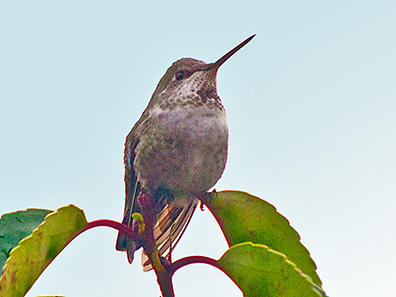 Mites are tiny, wingless arachnids, relatives of spiders. ticks and scorpions. There are over 30,000 species of mites living in a wide variety of habitats. Some are free-living in soil, water, and elsewhere and some are parasitic. Nearly all are very tiny, usually less than 1mm long. There are a group of mites called hummingbird-flower mites. These tiny mites live in flowers that are pollenated by hummingbirds. Hummingbird-pollinated flowers tend to be long and tubular and the mites spend their entire lives deep within some of these flowers. As a flower begins to age and wither, these mites must seek the protection of a fresher flower if they are to survive. They may be able to walk to an adjacent flower on the same inflorescence, but they are unable to reach another flower on a different plant without some help. Here is where the hummingbird is of assistance.
Mites are tiny, wingless arachnids, relatives of spiders. ticks and scorpions. There are over 30,000 species of mites living in a wide variety of habitats. Some are free-living in soil, water, and elsewhere and some are parasitic. Nearly all are very tiny, usually less than 1mm long. There are a group of mites called hummingbird-flower mites. These tiny mites live in flowers that are pollenated by hummingbirds. Hummingbird-pollinated flowers tend to be long and tubular and the mites spend their entire lives deep within some of these flowers. As a flower begins to age and wither, these mites must seek the protection of a fresher flower if they are to survive. They may be able to walk to an adjacent flower on the same inflorescence, but they are unable to reach another flower on a different plant without some help. Here is where the hummingbird is of assistance.
As a hummingbird feeds, it probes deeply into the flower to sip the nectar, the mites quickly run onto the hummingbirds bill and run up the length of the bill and into the hummingbird’s nostrils. Here, they will remain until the hummingbird probes into a fresher flower of the same species. Then, the mites quickly emerge from the nostril, run down the bill and into the flower. The hummingbird has unwittingly provided a taxi service for these tiny mites. Sometimes, the mites will cling to the base of the bill below the nostril instead of in the nostril. In either case, the mites are simply along for the ride and do no direct harm to the hummingbird.
The mites are very fussy about where they live, choosing to live only in one species of flower. There are many species of hummingbird-flower mites and each species will live only in one species of flower, so there is no competition between mites. Nearly all hummingbird-flower mites are found from Mexico to South America. At least one species does range as far north as the southern California coast, choosing a species of Indian Paintbrush in which to live. While the mites will each live in only one kind of flower, they are not fussy about what kind of hummingbird they choose as their transportation. Whatever kind of hummingbird probes the flower at the right moment will be selected to provide the necessary ride.
The mites simply want a ride and do not directly harm the birds. However, there is an indirect affect. The mites feed upon the flower nectar and thus provide direct competition with the hummingbirds for food. Flowers with mites have significantly less nectar than the same kind of flowers without mites.
#30 — Longest Migrations
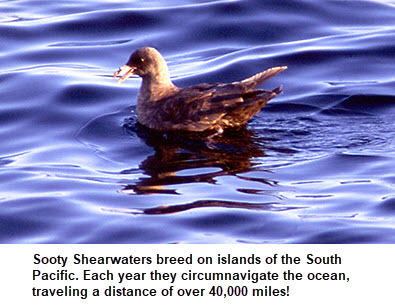 For many years the Arctic Tern was considered the champion of long-distance bird migration. It breeds in the Arctic and spends the non-breeding season in Antarctica—an annual pole-to-pole trip of over 12,000 miles! We now know this pales in comparison to the distance traveled by another bird: the Sooty Shearwater.
For many years the Arctic Tern was considered the champion of long-distance bird migration. It breeds in the Arctic and spends the non-breeding season in Antarctica—an annual pole-to-pole trip of over 12,000 miles! We now know this pales in comparison to the distance traveled by another bird: the Sooty Shearwater.
Sooty Shearwaters are one of the most numerous of all seabirds. They are found across both the Atlantic and Pacific Oceans and breed on islands of the South Pacific from New Zealand to eastern Australia and some breeding colonies can exceed 2.5 million pairs of birds. After breeding, these birds disperse to the west and north over both oceans, aided by the prevailing winds, and eventually circumnavigate the ocean to ultimately return to their southern breeding grounds. For Pacific populations, these birds leave their breeding islands and fly over the western Pacific, heading north toward Korea and the Bering Sea. Some birds apparently first fly toward South America to feed in waters west of Peru, then return toward the South Pacific or Hawaii before continuing north. Once they have reached the Arctic waters, they feed on the rich resources these waters provide, and then begin the journey south again. Large numbers of Sooty Shearwaters fly along our coast each year until they reach Southern California or Baja where they fly southwest toward Hawaii then on to their southern breeding islands near New Zealand and Australia. As they pass by our coast in the fall, they are often several miles offshore, but sometimes these.birds are near enough to shore to be seen with binoculars, skimming just above the surface of the water. To make this incredible journey each bird will fly 40,000-44,000 miles over open ocean each year, well surpassing the 12,000 miles of the Arctic Tern. Considering that these birds live more than 30 years, each bird then travels a distance of more than 3 roundtrips to the moon in their lifetimes!
#31 — Hummingbird Incubation
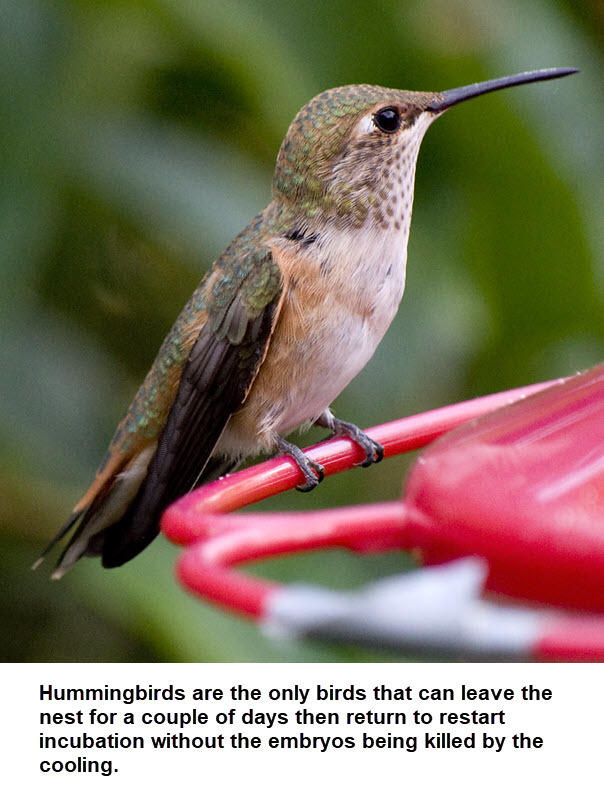 When birds incubate their eggs, heat from their body is transferred to the eggs, warming the embryo inside. At these warm temperatures, the embryo begins to grow and develop. In some kinds of birds, incubation begins when the first egg is laid, but other birds wait until the entire clutch is laid before incubating. Each species typically lays a certain number of eggs in each clutch normal for that species. Regardless of when the eggs are begun to be incubated, the eggs will hatch in a set number of days after being laid.
When birds incubate their eggs, heat from their body is transferred to the eggs, warming the embryo inside. At these warm temperatures, the embryo begins to grow and develop. In some kinds of birds, incubation begins when the first egg is laid, but other birds wait until the entire clutch is laid before incubating. Each species typically lays a certain number of eggs in each clutch normal for that species. Regardless of when the eggs are begun to be incubated, the eggs will hatch in a set number of days after being laid.
For example, in Barn Owls, the eggs are laid 2-3 days apart but incubation begins with the first egg. That means that each consecutive egg will hatch 2-3 days later than the previous egg, giving a mixture of ages of the new chicks.
In many other birds, such as shorebirds, waterfowl or most songbirds, the entire clutch is incubated simultaneously beginning with the last egg laid. In this case, all of the chicks hatch at the same time, or nearly so. Because the first eggs of the clutch were not immediately incubated, they did not get warm enough to begin development ahead of the later eggs. Once incubation begins and the embryos begin to grow, the eggs cannot be allowed to cool or the embryo will die. In many cases, the incubating parent can leave to make short trips for feeding, but only for very short periods of time. In some birds, the parents take turns incubating. Killdeer, for example, will frequently trade duties so that the eggs are never exposed. In many birds, the female does most of the incubation, leaving only very briefly and her mate brings most of her food to her. If developing eggs are left for a few hours and not kept warm, the embryo will cool and die.
Hummingbirds, however, are an interesting exception. Their eggs can be cooled and rewarmed without killing the embryo. For nearly all birds the time from egg-laying to hatching is a fixed number of days; it is around 12 days, for example, in an American Robin. In hummingbirds, though, the timing is variable, perhaps 12-19 days for some species. If the weather cools significantly or becomes very wet, some hummingbirds will abandon their nest for a day or more until conditions improve. As the abandoned eggs cool, the embryo inside stops its growth and development. In a few days, the female returns and resumes incubation. The embryos within the eggs rewarm and resume development. This allows hatching to be delayed a few days so that conditions may be more favorable. More importantly, such a process allows for these small birds to seek shelter away from the nest when conditions are bad and perhaps spend more time in torpor or at least at cooler body temperatures than needed for incubation. No other bird has this ability to cease then resume development in mid-incubation. They may be small, but these are amazingly tough little birds.
#32 — Black-colored Birds and Heat
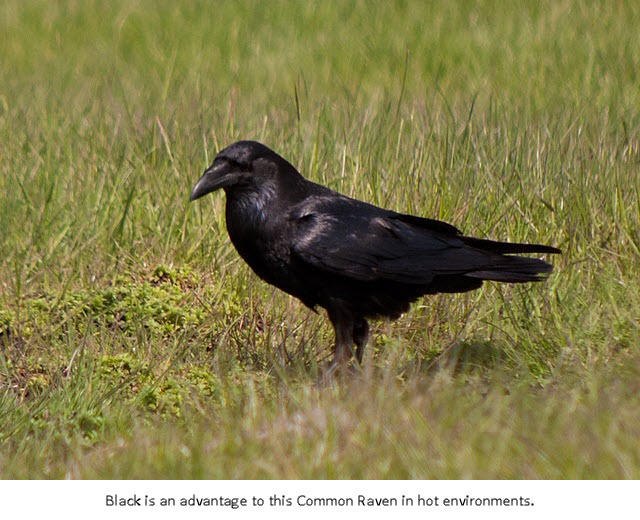 Turkey Vultures and ravens are black; magpies are mostly black. These, and other dark-colored birds are found in hot, desert environments. This may seem contradictory: after all, black absorbs heat.
Turkey Vultures and ravens are black; magpies are mostly black. These, and other dark-colored birds are found in hot, desert environments. This may seem contradictory: after all, black absorbs heat.
What keeps these birds from overheating? Birds have no sweat glands to help them keep cool and their usual means of evaporative cooling would be panting. But continual panting could result in too much moisture being lost, leading to dehydration. So… how do black-colored birds stay cool in hot environments?
Black can help with heat regulation in different ways with different birds. A Dark-eyed Junco has black skin, under its feathers. On a sunny, cool day, it may spread its feathers to allow the sun to penetrate under the feathers to the skin. The black pigment in the skin absorbs heat and warms the bird. But this is exactly what is undesirable in hot environments.
Ravens, Turkey Vultures and most other dark birds that live in hot environments have light-colored skin under their feathers. But, black feathers are actually very helpful. Here’s why: black pigment (melanin) in the feathers absorbs heat, warming the feathers. Since the feathers are not held tightly in contact with the skin, as the feathers absorb sunlight, they become warmer than the underlying skin. This temperature gradient, or difference, sets up an air flow between the feathers and the skin. This airflow is strong enough to pull some heat away from the body and assist with keeping the bird from overheating. So, black feathers are actually beneficial to birds living in hot environments.
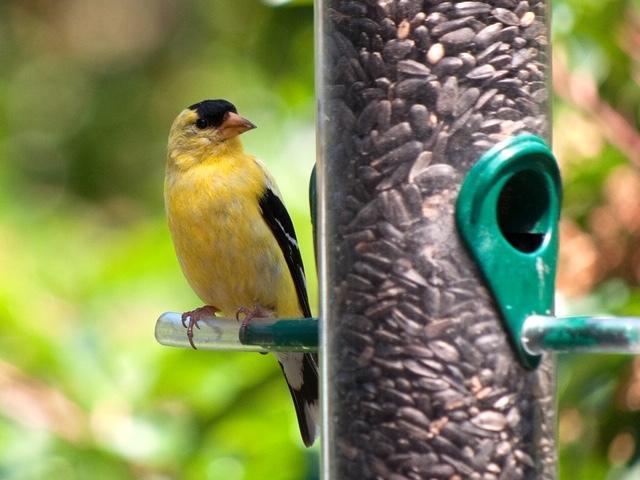 #33 — Goldfinch Breeding
#33 — Goldfinch Breeding
We tend to think of the breeding season for North American birds as occurring mostly during spring. For most of our passerines (songbirds) this is generally true. But breeding times vary widely for many kinds of birds. Great Horned Owls begin nesting in late December. Anna’s Hummingbirds are often on nests by mid-February in the Pacific Northwest and earlier in southern California. Breeding has been recorded for all months of the year in Mourning Doves, especially southern populations. Red Crossbills breeding is closely tied to the production and abundance of conifer cones and can breed whenever the opportunity arises, but most often from January to early June. The American Goldfinch is the latest regular breeding passerine in North America. Other species of goldfinches breed earlier but American Goldfinches don’t breed until very late June or early July. (See note below). Their breeding seems to be stimulated by an abundance of blooming composites such as thistles and dandelions. These tiny seeds are important for providing some of the plant material used in the nest, but more importantly, these tiny seeds provide food for newly hatched young. Nearly all seed-eating birds feed their young a diet of insects. Plant material is hard to digest and insects provide a good source of digestible protein for rapidly growing young. The American Goldfinch is an exception. They never eat insects unless it is by accident while grabbing a seed. Their young are feed seeds from day one and never get insects. House Finches also feed their young plant material, but it is a partially digested mass that is regurgitated and fed to youngsters for their first few days. The tiny seeds are important nutritionally and are a size that newly hatched goldfinches can handle.
American Goldfinches are also unique in being the only finch with two annual molts; one in the spring and one in the fall at the end of the breeding season. This late spring molt may also be partially responsible for the delayed breeding. It simply takes too much energy to molt and grow new feathers and to also breed. Each activity requires a large portion of the bird’s energy and resources.
American Goldfinches are easily attracted to feeders with sunflower seeds (best if out of the shell) or Nyjer. Since they are strict vegetarians, they have no interest in suet or suet-based products. Once they begin breeding, they may come to your feeder less than before because the naturally-occurring very tiny seeds are more attractive for feeding young birds.
In the bird world, as elsewhere, there are always exceptions to the rule. I noted that breeding is very late, but the subspecies of American Goldfinch found west of the Cascades has breeding records as early as early May. Later nesting is normal, but not everyone follows the rule. Such early nesting birds can cause problems for other birds sometimes. Goldfinches bind their nest together with spider silk. To obtain this, they sometimes partially tear apart Bushtit nests because Bushtits use lichen and spider silk to build their nests. Not good for the Bushtits but an easy source of material for early nesting Goldfinches.
#33 — Goldfinch addendum
Here is some interesting information to add to my short article about American Goldfinches. I should know better than to say “never” because nature will always find an exception to throw your way.
I said that American Goldfinches never eat insects. I should have said very rarely eat insects. Since writing that piece, a friend, Ron Dudley an outstanding bird photographer near Salt Lake City, has sent me photos that clearly show an American Goldfinch deliberately eating aphids from the stalk of a thistle flower. Ants were also present but they were left untouched. I suspect that the aphids were not deliberately sought after but were eaten once the goldfinch came upon them. Over the centuries, naturalists have analyzed the stomach contents of many different birds to determine what they eat. In the rare instances when insect parts were found in goldfinch stomachs, those insects that were identifiable were nearly always aphids. And, it has always been assumed that these were eaten by accident while foraging for plant material, but Ron’s photos show more than accidental consumption.
When aphids feed, they pierce a single plant cell. The internal pressure in the plant cell forces some of the cell’s liquid contents into the aphid. This forces a drop to be exuded from the rear-end of the aphid. This droplet is called honeydew because it is a sweet, sticky liquid. Some ants seek this honeydew and deliberately herd and tend to the aphids. This is why the ants were present on this thistle in Ron’s photos. I suspect that in the process of seeking thistle seeds as food, or thistle down to use in nest construction, the goldfinch accidentally ate an aphid and found the sweetness attractive and began to consume more aphids.
This is an interesting addition to learning more about the life of goldfinches. And, it’s a good lesson about using the term “never.” I’m sure an ostrich will never fly on its own, but for most aspects of nature, it’s unwise to say never. It’s part of what makes studying about nature so much fun.
The other fascinating thing about science, also, is that we may think we know all there is to know about a topic, for instance, goldfinches, or even a virus. Then, when new information that is provable becomes known, we then need to change our knowledge base about that topic, to accommodate the new information that has arisen. It’s not really that we were “wrong” initially, it’s more than we learned new information and now change our overall knowledge base about it based on the new, provable information.
#34 — Footedness in Birds
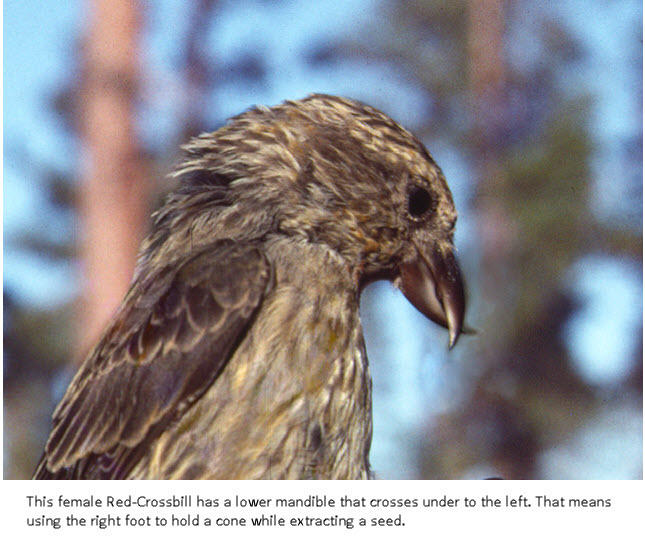 As humans, we usually have one hand that is dominant, one we prefer to use for most tasks. The right hand is preferred for approximately 90% of the world’s people. Fewer than 10% of people are left-handed and only a very few people use either hand with equal ease. This kind of lateralization is a function of a brain with two hemispheres and seems to allow for some multitasking.
As humans, we usually have one hand that is dominant, one we prefer to use for most tasks. The right hand is preferred for approximately 90% of the world’s people. Fewer than 10% of people are left-handed and only a very few people use either hand with equal ease. This kind of lateralization is a function of a brain with two hemispheres and seems to allow for some multitasking.
We may think of it as a human trait but “handedness” (or “footedness” in the case of birds), is found in other animals as well. Birds may be right or left-footed. Parrots frequently pick up and handle objects, especially items of food. Since their eyes are on both sides of the head, one eye only is closely examining the object. If the preference is to look with the left eye then it is the left foot that more easily picks up an object. As it turns out, most parrots are left-footed. In some species this is so strong that nearly all individuals of that species use the left foot. Sometimes, juveniles experiment with either foot before ultimately using the left foot. Only a few species of parrots seem to use the right foot.
Many species of passerines (songbirds) seem to be either right or left-footed with individuals of a given species showing this variation within the species, unlike the parrots where most members of a species are all the same. In most passerines that have been tested it appears that right-footed and left-footed individuals are nearly equal in any given population of a species.
Experiments have been done to see if any advantage is gained by being right or left-footed. In one experiment, the birds were given mealworms which they held against a perch with their foot until they could be eaten. The researchers found the birds used either the right or left foot equally within a species but each individual bird used the same foot each time. The researchers could find no advantage gained by using either foot.
But right-footedness did have one measurable advantage. It seems that right-footed birds could escape from a perch more quickly than left-footed birds and were caught less often. More work is needed to understand why and since both are found equally in the population, left-footedness must provide some advantage that we don’t yet understand.
In crossbills, the direction to which the lower mandible curves under the upper bill determines the footedness of the bird. The mandibles are curved left to right or right to left equally in the population. If the bird’s lower mandible crosses under to the right then the left foot is used and vice-versa.
Even Osprey seem to have a preference for which foot is mostly used. If a fish is caught with only one foot then either foot is equally used. When carrying a large fish, an Osprey uses both feet and 65-75% of the time the left foot is forward as the fish is being carried. Waterfowl and wading birds frequently stand on one foot while resting. Some species show a marked preference for which foot they stand on, yet other species show no obvious preference.


